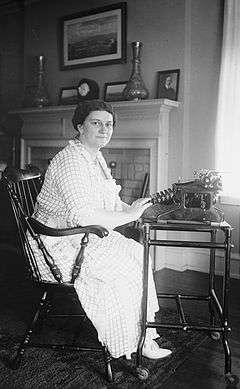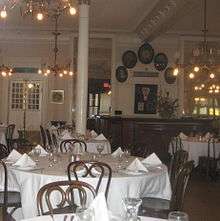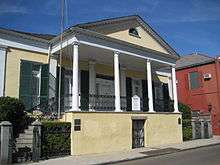Frances Parkinson Keyes

Frances Parkinson Keyes (July 21, 1885 – July 3, 1970) was an American author, and a convert to Roman Catholicism, whose works frequently featured Catholic themes and beliefs. Her last name rhymes with "skies," not "keys."
Life and career
Frances Parkinson Wheeler was born in Charlottesville, Virginia. She married Henry W. Keyes ("Henry Wilder, always called Harry")[1] on June 8th, 1904.[2] They had three sons together. They lived in Washington, D.C., and Virginia for a quarter of a century while Henry, a Republican, served in the United States Senate. He had earlier served as Governor of New Hampshire. The story of their courtship is told in Mrs. Keyes' first autobiography, Roses in December. The story of their marriage is recounted in her second autobiography, All Flags Flying. Henry Keyes was much older than his bride and, having never married before, was quite set in his ways. Early on he was dismissive of his wife's writing talent, and the acceptance of her first manuscript by a reputable publisher was a triumph personally as well as professionally. She wrote a series of articles for Good Housekeeping magazine beginning in the 1920s titled "Letters from a Senator's Wife." These were eventually collected into a book by the same name, one of three nonfiction books she wrote about her experiences in Washington. (The others were Capital Kaleidoscope and All Flags Flying. Her 1941 novel All That Glitters is also about Washington politics.)
Educated privately at home and later at Miss Windsor's school in Boston, Keyes had college ambitions that she abandoned upon her engagement. It was a loss she felt so acutely that, according to her autobiography "Roses in December," she extracted a promise from her fiance that should they ever have a daughter, she would be given the opportunity to attend college. Mrs. Keyes commented that this was the only promise she asked for upon her engagement, and that it was highly unusual in that era for an unmarried couple to speak of possible future children - a measure of how strongly she felt about education and how greatly she regretted her lost opportunities. Her education was supplemented with extensive travel in Europe, and she grew up trilingual, speaking English, French and German. Health issues forced her to abandon her study of Greek in school as her mother and physician felt she was carrying too heavy an academic load.

Keyes' first book, The Old Gray Homestead, was published in 1919. In 1934 Keyes received an honorary Litt.D. from Bates College. Upon her spouse's death in 1938, she wrote books and magazine articles prolifically. Her novels are set in New England, Virginia, Louisiana, Normandy and South America, reflecting her upbringing and extensive travel.
In the 1950s, she purchased the historic Beauregard House in New Orleans’ French Quarter and became a fixture of New Orleans life. The house was built by the grandfather of chess master Paul Morphy, whose life is the subject of Keyes' book The Chess Players.[3] The circumstances of the house's construction and early habitation are told in that book. Today the house is a museum. Many of Keyes' books are set in southern Louisiana and she eloquently described societal life and conventions in her historical novels. Keyes' novel Blue Camellia tells about the development of south Louisiana from swampland to productive rice farms. The River Road deals with the sugar plantations of the Mississippi River Delta and Crescent Carnival (her first Louisiana novel) tells the history of Carnival since the 1890s (with a good deal about Creole culture and its decline during that period). Once On Esplanade: A Cycle Between Two Creole Weddings is a fictionalized biography, originally written for teenage girls, of the Creole woman who provided Keyes with much of her understanding of Creole life between the Civil War and the First World War. Given the details with which Keyes writes about her subject matter, it is easy to forget her books are novels. She went to great lengths to research her subject matter and ensure the historical, geographical, linguistic and even scientific accuracy of her writings. Many of her books include a dozen or more real people among the characters, many famous, some obscure and some even still living at the time she wrote them into her books (with their permission, of course). Keyes traveled on location to learn about her topics and enlisted local historians and residents to assist her. The meticulousness of her detailed accounts make her novels valuable tools for learning about a time long past and customs that have died away.
Modern readers will find her depictions of African-American characters generally regressive and simplistic, and there are occasional patches of the pre-World War II fashionable anti-Semitism in her Jewish characters. Some of her Irish and Italian characters are cliched, or even burlesques of stereotypes. While Keyes was a popular author of the 1940s and 50s, existing editions of her books are becoming rare, and many libraries have unfortunately purged her books from their shelves. However, a lively trade in Keyes books exists on Amazon.com, eBay and other auction sites, especially those devoted to books. There are a number of fan discussion sites devoted to her work, especially her Catholicism, which appeals to her many Catholic fans.
Keyes' conversion to Catholicism can be traced through her writings. As her world expanded from that of an educated New Englander to an increasingly sophisticated political wife and international traveler, so did her interest in the Catholic religion. She met many devout Catholics who were leaders beyond the realm of the Church. In the introduction to "Tongues of Fire," her book about Christian missionaries fueled by the Holy Spirit, she humorously notes that it may have been during the hour-long sermons of the Congregationalist church that she "took her first steps toward Catholicism."
Keyes strongly believed in the virtue of chastity and furthermore believed that it was important for a woman to be a virgin on her wedding night. Her morality of courtship and marriage will seem strange and impractical to contemporary readers. However, Keyes wrote with sensitivity about the lives of people trapped in the conventional morality she advocated: individuals trapped in loveless marriages, those unfairly stigmatized by their peers, those struggling with temptation, young people suffocated by the Victorian-era rules of courtship, and those born out of wedlock.
Keyes died in 1970, at the age of 84, in New Orleans.[4]
Louisiana and Mississippi Valley novels
The first of Keyes' novels set in Louisiana was Crescent Carnival, which tells the story of three generations of two intertwined families. The Breckenridges are protestants, while the Fontaines are Catholic Louisiana Creoles, and the plot hinges on the way that pride and misfortune conspire with cultural and political differences to keep prospective lovers from marrying. The cycle of failure only ends with two people have the courage to defy the odds and accept their love for each other. Carnival celebrations—mostly Carnival balls, but also including Mardi Gras parades—form the backdrop of many scenes. An incident involving two Mardi Gras parades facing off when they nearly collide is based on a true story, as recorded by Robert Tallent in his book, Mardi Gras.
The River Road is set against the backdrop of an old family sugar plantation, and the d'Alvery family that struggles to keep it viable between the two world wars. The River Road is notable among Keyes' books for the tragic endings of two out of the three marriages chronicled in the novel. Most characters do not experience a 'happy ending'. In the UK, The River Road was published as two volumes, The River Road (Parts I-VI of the U.S. publication) and Vail d'Alvery (Parts VII-XI of the U.S. publication).

Steamboat Gothic is a true gothic novel set on Louisiana's famed River Road. The plantation home that inspired this novel is still in existence and open for daily tours. The plantation is called "San Francisco" and its mid-Victorian architecture is reminiscent of a steamboat. Set between 1865 and the Depression, Steamboat Gothic discusses the change in transportation methods from steamboat to railroad and the effect the change had upon the plantations along the River Road. In the UK, Steamboat Gothic was published as two volumes, Steamboat Gothic in 1952, and Larry Vincent in 1953. The first book covers a period from 1869 to 1895, and the second a period from 1897 to 1930. Eyre and Spottiswoode published both titles in the UK.
Mrs. Keyes also lived for a time in one of the plantations along the River Road. "The Cottage" was located north of the area known as Duncan's Point and was the setting for her novel, The River Road. "The Cottage" burned to the ground in the 1960s. However, the ruins of the place still remain.
Blue Camellia is set in the prairie country of South Louisiana and takes place on a rice farm. The protagonist and his wife are transplanted Midwesterners who arrive in Cajun country and see the Cajun culture through the eyes of outsiders.

The murder mystery Dinner at Antoine's, set in the immediate aftermath of World War II, became Keyes' biggest seller (and was also her only mystery, apart from the England-set The Royal Box, which has a few of the same characters). The plot is an interesting twist on the "Least Likely Person" concept of the murder mystery and is notable for "playing fair" with the reader: all the clues you need to solve the mystery are embedded in the novel. A subplot involving diplomatic and political manipulation made use of Keyes' experiences in Washington DC as a Senator's wife.
Madame Castel's Lodger is a fictionalized biography of General P. G. T. Beauregard. Keyes' other Civil War novel is The Chess Players a highly fictionalized biography of Paul Morphy, the world chess champion who was born in New Orleans.
Keyes' Louisiana novels are loosely tied together by bits of common background that pop up in various books. Antoine's Restaurant appears at least briefly in all but Blue Camellia. General Beauregard also appears in each of the books set before 1900, and is mentioned in some way in all but one of the others (again, the exception is Blue Camellia). Paul Morphy is the lead character in The Chess Players and is discussed in several other books. A slightly ribald anecdote about a panicked Creole bride on her wedding night is told in The River Road and is mentioned in Once on Esplanade, Madame Castel's Lodger, The Chess Players and others. The Villere family are at center stage in Once on Esplanade and reappear (especially Madame Villere, Keyes' friend) in most of the other Louisiana books. The reader has the sense of a single, unified narrative world underlying the entire Louisiana set of novels.
Her Louisiana novels contained lengthy forewords or postscripts detailing her background research (including bibliographies) and listing the many people who provided her with information and/or inspiration.

Her home in New Orleans, the Beauregard-Keyes House in the Vieux Carré, is now a museum. It is located at 1113 Chartres Street, New Orleans, LA 70116, USA. Telephone: (504)523-7257. Formerly lived in, but not owned by, Confederate General P. G. T. Beauregard, Keyes restored the mansion to its Victorian glory, and her studio remains on display, complete with manuscripts. Now known as the Beauregard-Keyes House and Garden, the museum contains extensive Keyes correspondences, as well as her collections of dolls, fans, adult-sized costumes collected on her world travels and rare [porcelain veilleuses], a kind of teapot in which the contents—anything from tea to milk—are kept warm by a small votive light. The veilleuse has the added bonus of serving as a nightlight and it was most commonly utilized at bedtime. Mrs. Keyes' mentioned the use of a veilleuse in several of her novels. Her veilleuse collection was and is one of the most extensive in the world, second only to one in Trenton, Tennessee. Mrs. Keyes' doll collection was highlighted in a biographical documentary produced by Laurie McGill for the United Federation of Doll Clubs, Inc. (www.ufdc.org) entitled "Once Upon a Time: The Story of the Dixie Doll."
The Beauregard-Keyes house appears none the worse for wear after [Hurricane Katrina] but the structure suffered roof damage. It has re-opened to the public.
Bibliography
Known works with original US publication dates (Louisiana / Mississippi Valley books) are marked with an asterisk*:
- The Old Gray Homestead (aka Sylvia Carey) (1919, novel)
- The Career of David Noble (1924, novel)
- Letters from a Senator's Wife (1924, memoirs)
- Queen Anne's Lace (1930, novel)
- Silver Seas and Golden Cities (1931, travelogue)
- Lady Blanche Farm: A Romance of the Commonplace (1931, novel)
- Senator Marlowe's Daughter (1933, novel) (aka Christian Marlowe's Daughter, UK)
- The Safe Bridge (1934, novel)
- The Happy Wanderer: The Collected Verse of Frances Parkinson Keyes (1935, poetry)
- Honor Bright (1936, novel)
- Written in Heaven: The Life on Earth of the Little Flower of Lisieux (1937, biography)
- Pioneering People in Northern New England: A Series of Early Sketches (1937, history)
- Capital Kaleidoscope: The Story of a Washington Hostess (1937, memoir)
- Parts Unknown (1938, novel)
- The Great Tradition (1939, novel)
- The Sublime Sheperdess: St. Bernadette Soubirous (1940, biography)
- Fielding's Folly (1940, novel)
- All That Glitters (1941, novel)
- Crescent Carnival (1942, novel - the first of the Louisiana books; aka If Ever I Cease To Love, UK)*
- Also the Hills (1943, novel)
- The River Road (1945, novel)*
- Came a Cavalier (1947, novel)
- Once on Esplanade: A Cycle Between Two Creole Weddings ( 1947, juvenile biography somewhat fictionalized)*
- Dinner at Antoine's (1948, novel, mystery)*
- Along A Little Way (1948, memoir and inspirational)
- The Cost of a Best Seller (1950, memoir and how-to book for aspiring writers)
- All This Is Louisiana: An Illustrated Story Book (1950, coffee-table photograph book)*
- Joy Street (1950, novel)
- St. Therese of Lisieux (aka Therese: Saint of a Little Way) (1950, biography)
- The Grace of Guadalupe (1951, biography)
- Steamboat Gothic (1952, novel)*
- The Ambassadress (1953, novel)
- The Royal Box (1954, novel, mystery)*
- The Frances Parkinson Keyes Cookbook (1955, cookbook)*
- St. Anne: Grandmother of Our Saviour (1955, biography)
- Blue Camellia (1957, novel)*
- Keeping Christmas (1957, inspirational)
- The Golden Slippers (aka Victorine) (1958, novel)*
- The Land of Stones and Saints, Doubleday & Co. Inc., New York City (1958, biography and history)
- Station Wagon In Spain (1959, novel)
- Mother Cabrini (1959, biography)
- Christmas Gift (1960, inspirational)
- Roses in December (1960, memoir)
- The Explorer (1964, novel)
- The Chess Players: A Novel of New Orleans and Paris (1960, novel)*
- The Heritage (1960, novel)
- The Rose and the Lily: The Story of Two South American Saints (1961, biography)
- Shelter (1961?, novel?)
- Madame Castel's Lodger (1962, novel)*
- Three Ways to Love: The Story of Three Great Women (1963, juvenile biography)
- A Treasury of Favorite Poems (poetry anthology, edited) (1963)
- The Restless Lady and Other Stories (1963, short stories)
- Christmas Is Everywhere (1964, inspirational)
- Christmas At Home (1965, inspirational)
- Tongues of Fire: The Story of Christian Missionaries from St. Paul to the Present (1966, history)
- I, the King (1966, novel about Philip IV of Spain)
- All Flags Flying: Reminiscenses Of Frances Parkinson Keyes (1972, memoir)
See also
References
- ↑ Roses in December. Frances Parkinson Keyes. Doubleday & Company, Inc. 1970. p. 31.
- ↑ Keyes, Frances Parkinson (1960). Roses in December. United States of America: Doubleday & Company, Inc. pp. 309 – 321.
- ↑ Wilson, Samuel (1993). The Beauregard-Keyes House. New Orleans, Louisiana: Laborde Printing Co. p. 16. ISBN 1-879714-05-1.
- ↑ "Milestones". Time. Time Inc. July 13, 1970. Retrieved June 24, 2010.
External links
- Works by Frances Parkinson Keyes at Project Gutenberg
- Works by or about Frances Parkinson Keyes at Internet Archive
- Finding Aid to Frances Parkinson Keyes Correspondence, 1927-1938 at the New York State Library, accessed February 16, 2016
- Keyes offers insight into her own life as a writer and the wife of a political leader, in an essay for "Catholic Authors":
- Very brief biography, a portrait of the author, and some images, all from the New Orleans Public Library collections:
- About Beauregard House in New Orleans:
- Partial list of Keyes' Louisiana books, from Louisiana's Literary Heritage:
- The Papers of Frances Parkinson Keyes are held at the University of Vermont, Special Collections Research Library. A finding aid and inventory are available upon request. The Keyes Papers contain extensive correspondence with her publisher, Julian Messner, and with her mother, Louisa.